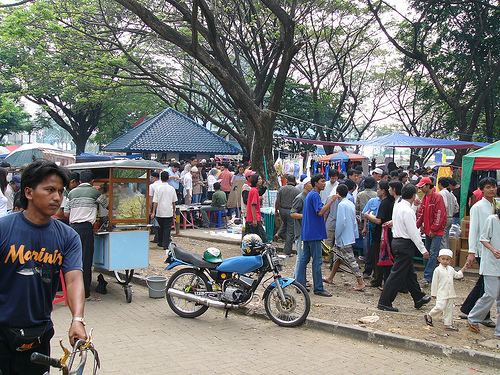Creative Commons Maha Kumbh Mela
As the Maha Kumbh Mela, the ancient Hindu festival and the world's largest religious gathering, came to a close in Allahabad in March this year, it brought to mind the classic question — 'if a tree falls in a forest and no-one is around to hear, does it make a sound?". For once the people were gone, the tents disassembled, and the pontoon bridges were taken away — does the city still exist?
The creation of space undergone in the city of Allahabad entailed building a pop-up city over 5,000 acres (20.2 sq km), making this event more than just a quest for spirituality for the estimated 100 million pilgrims who bestowed their presence on the camping grounds over the course of the month-long festival.
This pop-up city is made manifest at the confluence of the Yamuna, Ganges and Saraswati rivers and creates space for markets, religious music, meditation and games. The city of tents is organised around a system of roads and bridges with specific routes making circulation quite fluid, putting to shame most of India's traffic-jammed roads where rules are rarely followed.
A display of successful urbanism?
What's interesting about the festival is the way this overnight and temporary city is formalised and organised by the same people who operate in cities which otherwise have no street design guidelines, poor traffic circulation patterns, and many problems in waste and water management. While much praise is due to the operators of the Kumbh Mela, there is much to be observed and learned from the overall emergent behaviour of this pop-up mega-city.
There are endless connections to be made between this pop-up city and "real" cities in India — the cacophony, the endless stretch of crowds, the smell of food cooking out in the open, acts of spirituality in a public setting and yes, lots of naked or near-naked people. At the Kumbh all of this activity arrives, is organised, activates, disassembles and leaves, and somehow this lends great appeal. The fantastical nature of such events such as the Kumbh or the Burning Man Festival in Nevada, US are attractive to urban planners and architects for this ephemeral quality — a small microcosm of a larger society, picture, or problem that we face in today's cities.
The Kumbh is created along the same guidelines as any other formalised economy. A set of documents denoting the "city limits" determines the area to be reserved for festival activities and a set of rules is put in place. The rules lay down the laws of the land regarding illness, waste, police authority and power of arrest, proper handling of animals, damage loss, how to dispose of dead bodies, and photography. Soft and hard infrastructures are set in place and areas are categorised as residential, commercial, religious, and circulation.
Community
The Kumbh has another layer to it, one that goes beyond infrastructure or technology, and that is one of community. Indian society is defined by its relationships and sense of community as is underlined by its traditional chowk housing and the ideologies behind familial relationships. The Kumbh allows for these traditions and ideologies to exist as a societal safety net and comfort to the millions who are on the same spiritual quest. Yet the irony is that this is happening in a city — the very kind of place that many find to be ruining India's societal traditions and family values.
The Maha Kumbh Mela happens every three years in one of four cities on a twelve-year rotation and the tradition of the event — the creation and destruction of a city — dates back millennia, long before New Delhi, Mumbai, Kolkata, Bangalore, Chennai and many other Indian cities were even on the drawing board. So then why is it that these time-tested systems have been ignored in the planning of Indian cities?
India is one of the oldest cultures on this planet, and the Kumbh portrays its obvious ability for organising and sustaining an urban setting of millions, yet India notoriously has some of the worst urban environments today. Perhaps it is the overwhelmingly spiritual nature of the Kumbh Mela that does not inherently bring to mind ideas about urban planning; or maybe it's that the supporting organisation and infrastructure fade into the background each year. Whichever the case, this urban phenomenon may hold many answers and ideas for India's urban march forward, and that in itself is the real phenomenon.


